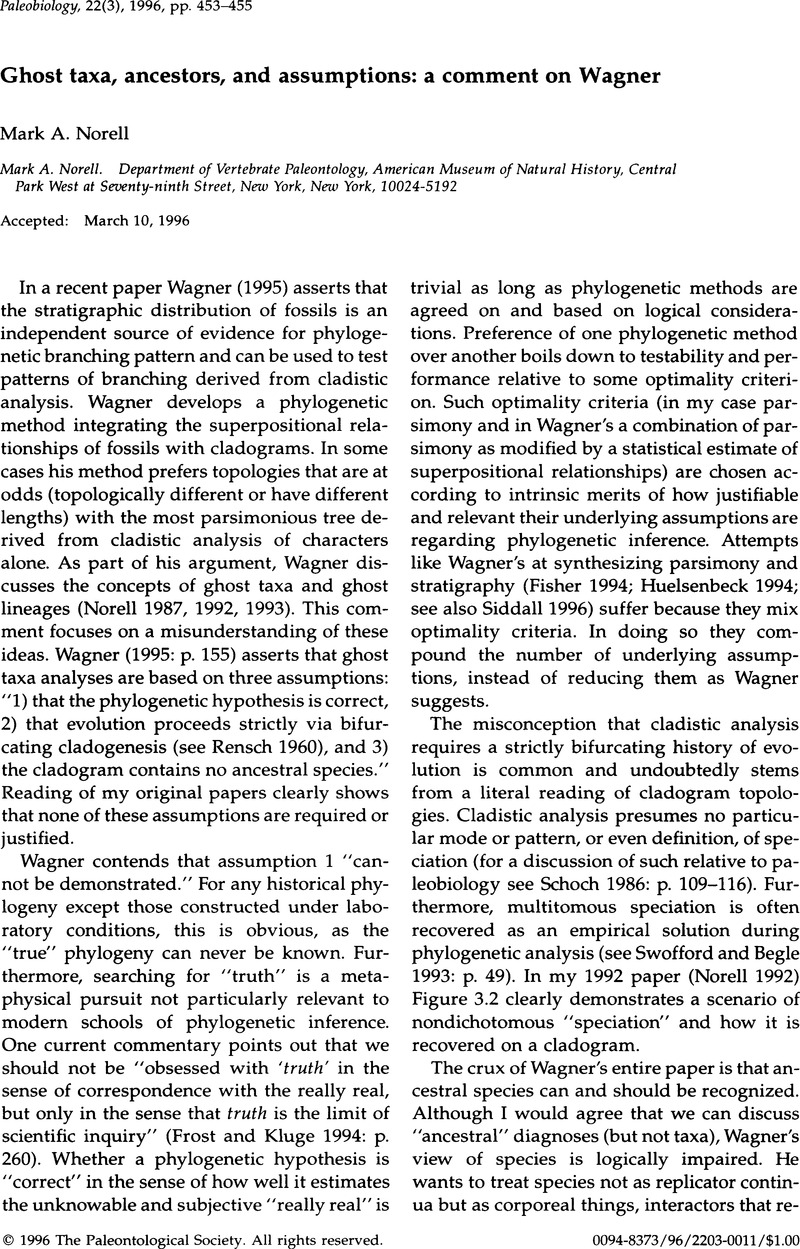Crossref Citations
This article has been cited by the following publications. This list is generated based on data provided by Crossref.
Clyde, William C.
and
Fisher, Daniel C.
1997.
Comparing the fit of stratigraphic and morphologic data in phylogenetic analysis.
Paleobiology,
Vol. 23,
Issue. 1,
p.
1.
Siddall, Mark E.
1998.
Forum. Stratigraphic Fit to Phylogenies: A Proposed Solution.
Cladistics,
Vol. 14,
Issue. 2,
p.
201.
Pryer, Kathleen M.
1999.
Phylogeny of Marsileaceous Ferns and Relationships of the Fossil Hydropteris pinnata Reconsidered.
International Journal of Plant Sciences,
Vol. 160,
Issue. 5,
p.
931.
O'Keefe, F. Robin
and
Sander, P. Martin
1999.
Paleontological paradigms and inferences of phylogenetic pattern: a case study.
Paleobiology,
Vol. 25,
Issue. 4,
p.
518.
Wagner, Peter J.
2000.
Phylogenetic analyses and the fossil record: tests and inferences, hypotheses and models.
Paleobiology,
Vol. 26,
Issue. sp4,
p.
341.
Wagner, Peter J.
2000.
Phylogenetic analyses and the fossil record: Tests and inferences, hypotheses and models.
Paleobiology,
Vol. 26,
Issue. S4,
p.
341.
Jablonski, David
2000.
Micro- and macroevolution: scale and hierarchy in evolutionary biology and paleobiology.
Paleobiology,
Vol. 26,
Issue. sp4,
p.
15.
Jablonski, David
2000.
Micro- and macroevolution: Scale and hierarchy in evolutionary biology and paleobiology.
Paleobiology,
Vol. 26,
Issue. S4,
p.
15.
Hanger, Rex Alan
and
Strong, Ellen E.
2000.
Phylogeny of the Anopliidae (Brachiopoda: Chonetidina).
Historical Biology,
Vol. 14,
Issue. 4,
p.
285.
Adrain, Jonathan M.
and
Westrop, Stephen R.
2001.
Fossils, Phylogeny, and Form.
Vol. 19,
Issue. ,
p.
291.
Pol, Diego
Norell, Mark A.
and
Siddall, Mark E.
2004.
Measures of stratigraphic fit to phylogeny and their sensitivity to tree size, tree shape, and scale.
Cladistics,
Vol. 20,
Issue. 1,
p.
64.
Miller, Ellen R.
Gunnell, Gregg F.
and
Martin, Robert D.
2005.
Deep Time and the Search for Anthropoid Origins.
American Journal of Physical Anthropology,
Vol. 128,
Issue. S41,
p.
60.
Pol, Diego
Norell, Mark A.
and
MacLeod, Norm
2006.
Uncertainty in the Age of Fossils and the Stratigraphic Fit to Phylogenies.
Systematic Biology,
Vol. 55,
Issue. 3,
p.
512.
Hermsen, Elizabeth J.
and
Hendricks, Jonathan R.
2007.
A method for constraining the age of origination of derived characters.
Cladistics,
Vol. 23,
Issue. 2,
p.
169.
Lelièvre, Hervé
Bagils, René Zaragüeta
and
Rouget, Isabelle
2008.
Temporal information, fossil record and phylogeny.
Comptes Rendus Palevol,
Vol. 7,
Issue. 1,
p.
27.
Mannion, Philip D.
Upchurch, Paul
Carrano, Matthew T.
and
Barrett, Paul M.
2011.
Testing the effect of the rock record on diversity: a multidisciplinary approach to elucidating the generic richness of sauropodomorph dinosaurs through time.
Biological Reviews,
Vol. 86,
Issue. 1,
p.
157.
Cantalapiedra, Juan L.
Fernández, Manuel Hernández
Alcalde, Gema
Azanza, Beatriz
DeMiguel, Daniel
and
Morales, Jorge
2012.
Ecological correlates of ghost lineages in ruminants.
Paleobiology,
Vol. 38,
Issue. 1,
p.
101.
Cantalapiedra, Juan L.
Fernández, Manuel Hernández
Alcalde, Gema
Azanza, Beatriz
DeMiguel, Daniel
and
Morales, Jorge
2012.
Ecological correlates of ghost lineages in ruminants.
Paleobiology,
Vol. 38,
Issue. 1,
p.
101.
Pérez, María Encarnación
Pol, Diego
and
Kolokotronis, Sergios-Orestis
2012.
Major Radiations in the Evolution of Caviid Rodents: Reconciling Fossils, Ghost Lineages, and Relaxed Molecular Clocks.
PLoS ONE,
Vol. 7,
Issue. 10,
p.
e48380.
Bapst, David W.
2014.
Assessing the effect of time-scaling methods on phylogeny-based analyses in the fossil record.
Paleobiology,
Vol. 40,
Issue. 3,
p.
331.



